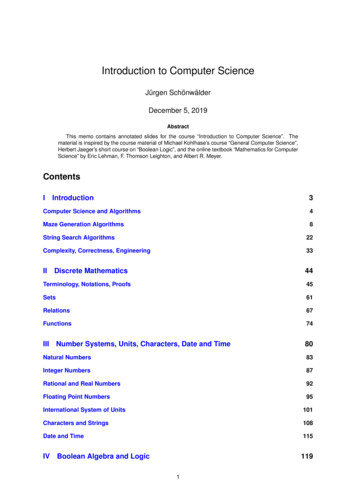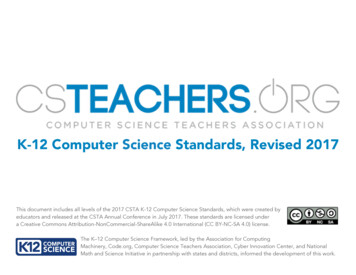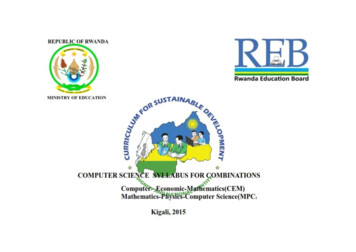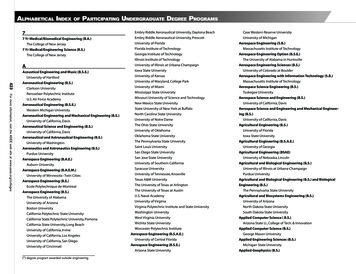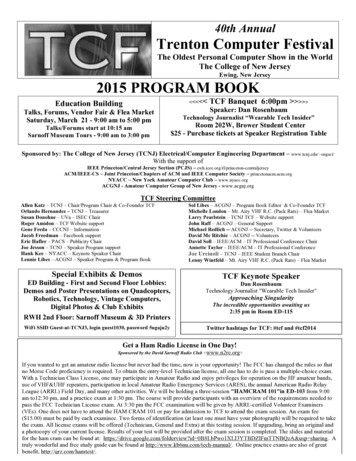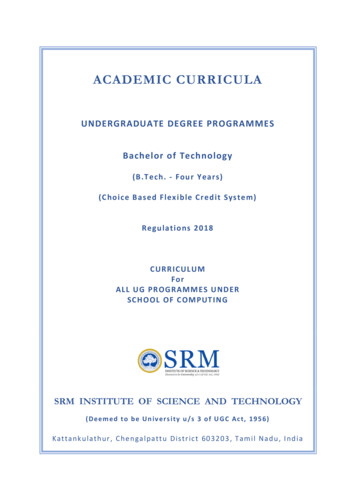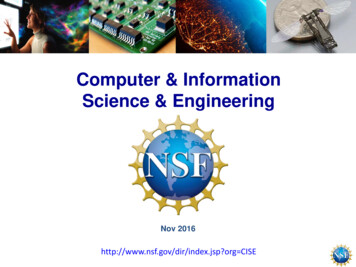
Transcription
Computer & InformationScience & EngineeringNov 2016http://www.nsf.gov/dir/index.jsp?org CISEImage Credit: Exploratorium.
National Science Foundation’s Mission“To promote the progress of science; to advance thenational health, prosperity, and welfare; to secure thenational defense.”Image: NSF's current headquarters, 4201 Wilson Boulevard, Arlington, VA. Credit: National Science Foundation
The National Science Foundation is vitalbecause we support basic research andpeople who make discoveries thattransform our future by:– driving the U.S. economy,– enhancing our nation’s security, and– giving the U.S. the competitive edge toremain a global leader.
Data Current as of 2014
NSF’s Merit Review ProcessVideo available at: http://go.usa.gov/ceSBJ
NSF supports all fields of S&E
CISE LeadershipCISE DirectorateJim Kurose, ADErwin Gianchandani, DADAdvancedCyberinfrastructure(ACI)Irene Qualters, DDComputing andCommunicationsFoundations (CCF)Rao Kosaraju, DDComputer andNetwork Systems(CNS)Ken Calvert, DDInformation andIntelligent Systems(IIS)Lynne Parker, DD
CISE’s Economic and Societal Context CISE is at the center of an ongoing societaltransformation and will be for decades to come. Advances in computing, communications andinformation technologies, and cyberinfrastructure:- accelerate the pace of discovery and innovation; and- are crucial to achieving national and societal priorities.Image Credit: ThinkStock(Cyber) SecurityImage Credit: Calvin Lin, UT,AustinEducation &Lifelong LearningImage Credit: NASAEnvironmentImage Credit: Public domainHealth & WellbeingImage Credit: Nicolle Fuller, NSFSmart & ConnectedCommunities
Economic impact of CISE: From Federallyfunded research to billion dollar industriesAdvances in computing,communications andinformation technologies, andcyberinfrastructure: drive U.S. competiveness, (e.g.,IT accounts for 25% of economicgrowth since 1995), and have profound impacts on ourdaily lives.201020001990Product( B, 10B)1980Industry1970From Continuing Innovation in Information Technology, NRC, 2012.University
. across many industries
and this impact will continueTop twelve economicallydisruptive technologies (by 2025)
Many STEM jobs are in computingSocial sciencesMathPhysical sciencesLife sciencesEngineersComputeroccupationsJob Openings 2014 – 2024 (growth and replacement)US Bureau of Labor StatisticsData from lsx
An amazing time for computing!UbiquityEngagementUrgencyComputing is everywhere – acrossall of science and engineering, andall of society.Computing intertwines with manycommunities.Computing is rapidly expanding andevolving; there is tremendousopportunity now!
CISE by the Numbers: FY 201523% successrate 933 MFY 2015researchbudget7,302senior researchers1,8871,278awardsother professionals8,039498proposalspostdoctoral associates17,8686,423people supportedgraduate students342panels2,367undergraduate students
NSF Support of Academic Basic Research(as a percentage of total federal support)Source: NSF/NCSES, Survey of Federal Funds for Research & Development, FY 2014
CISE Research InvestmentsExploring the frontiers of computing Strong commitment to core/fundamental research – the heart of what we do. Cast a broad net & let the best ideas surface. Engage with our community to develop new research ng andCommunicationFoundations (CCF)AlgorithmicComputer andNetwork Systems(CNS)Information andIntelligent Systems(IIS)FoundationsComputer SystemsResearchCyber HumanSystemsHigh PerformanceComputingCommunicationand InformationFoundationsNetworkingTechnology andSystemsInformationIntegration andInformaticsNetworking/CybersecuritySoftware andHardwareFoundationsEducation areCore research programsCross-cutting research programs
CISE DivisionsAdvanced CyberinfrastructureComputing & CommunicationFoundationsAdvanced Cyberinfrastructure supports and coordinatesthe development, acquisition, and provision of state-of-the-artcyberinfrastructure resources, tools and services essential tothe advancement and transformation of science andengineering.Computing and Communication Foundations advancescomputing and communication theory, algorithms forcomputer and computational sciences and architecture anddesign of computers and software.Computer and Network Systems invent new computingand networking technologies and finds new ways to makeuse of current technologies.Computer & Network SystemsInformation & Intelligent SystemsInformation and Intelligence Systems studies theinterrelated roles of people, computers, and information toincrease our ability to understand data, as well as to mimicthe hallmarks of intelligence in computational systems
Advanced Cyberinfrastructure (ACI)http://www.nsf.gov/div/index.jsp?div ACISupports the acquisition, development, and provision ofstate-of-the-art cyberinfrastructure resources, tools, andservices essential to the conduct of 21st century scienceand engineering research and education.– Data: Support scientific communities in the sharing and archiving of, as well ascomputing with data by creating building blocks to address common communityneeds in data infrastructure.– High Performance Computing: Enable petascale computing; provide openscience community with state-of-the-art HPC assets ranging from looselycoupled clusters to large scale instruments; develop an integrated scientific HPCenvironment.– Networking and Cybersecurity: Invest in campus network improvements and reengineering to support a range of activities in modern computational science.Support transition of cybersecurity research to practice.– Software: Transform innovations in research and education into sustainedsoftware resources that are an integral part of cyberinfrastructure.– Learning and Workforce Development: Invest in educational and trainingprograms to meet current and future needs of CI professionals, developers, andusers.
Computing & Communication Foundations (CCF)http://www.nsf.gov/div/index.jsp?org CCFSupports research and education projects that explore thefoundations of computing and communication devices.– Algorithmic Foundations (AF): Innovative research characterized byalgorithmic thinking and algorithm design, accompanied by rigorousmathematical analysis.– Communications and Information Foundations (CIF): Transformativeresearch addressing the theoretical underpinnings and current andfuture enabling technologies for information acquisition, transmission,and processing in communication and information networks.– Software and Hardware Foundations (SHF): Foundational researchessential to advance the capability of computing systems, includingsoftware and hardware components, systems, and other artifacts.
Computer and Network Systems (CNS)http://www.nsf.gov/div/index.jsp?div CNSSupports research and education activities inventing newcomputing and networking technologies and exploringnew ways to make use of existing technologies.– Computer Systems Research (CSR): Transformative research onfundamental scientific and technological advances leading to thedevelopment of future generation computer systems, including newarchitectures; distributed real-time embedded devices; pervasive,ubiquitous and mobile computing; file and storage systems; operatingsystems; reliable, fault-tolerant and secure hard/middle/software.– Networking Technology and Systems (NeTS): Transformative researchon fundamental scientific and technological advances leading to theunderstanding, development, engineering, and management of futuregeneration, high-performance computer networks.
Information and Intelligent Systems (IIS)http://www.nsf.gov/div/index.jsp?div IISSupports research and education activities that study theinter-related roles of people, computers, and information.– Cyber-Human Systems (CHS): Research to accelerate the creationand understanding of the complex and increasingly coupledrelationships between humans and computing with the broad goal ofadvancing human capabilities: perceptual and cognitive, physical andvirtual, social and societal.– Information Integration and Informatics (III): Information technologyresearch on the processes and technologies involved in creating,managing, visualizing, and understanding diverse digital content incircumstances ranging from individuals through groups,organizations, and societies, and from individual devices to globallydistributed systems, and that can transform all stages of theknowledge life cycle.– Robust Intelligence (RI): Research that encompasses all aspects ofthe computational understanding and modeling of intelligence incomplex, realistic contexts to advance and integrate the traditions ofartificial intelligence, computer vision, human language research,robotics, machine learning, computational neuroscience, cognitivescience, and related areas.
CISE programs to address national prioritiesImage Credit: ThinkStockImage Credit: CCC and SIGACT CATCSBig DataCybersecurityImage Credit: Texas Advanced Computing CenterNational StrategicComputing InitiativeImage Credit: US IgniteSmart CitiesImage Credit: Eliza Grinnell/Harvard SEASNational RoboticsInitiativeImage Credit: ThinkStockUnderstanding theBrainImage Credit: WINLAB, Rutgers UniversityImage Credit: Calvin Lin, University of Texas, AustinComputer Sciencefor AllAdvanced WirelessResearchFor a comprehensive list of CISE funding opportunities, visit:http://www.nsf.gov/funding/pgm list.jsp?org CISE
National Big Data R&D Initiative Initiative launched by OSTP in March2012 Major Announcements: NSF,NIH, USGS, DoD, DARPA, DOE Data to Knowledge to Action eventhosted by OSTP November 2013 Encouraged public-privatepartnerships across the country NSF’s strategy to address Big Dataincludes research,cyberinfrastructure, education andtraining, and community building.nsf.gov/cise/bigdata
Critical Techniques, Technologies and Methodologies forAdvancing Foundations and Applications of Big DataSciences and Engineering (BIGDATA)Developing techniques to manage and analyze data Cornerstone of the National Big Data R&D Initiative launchedMarch 2012. Two categories for submission:– Foundations: Encourages fundamental techniques, theories,methodologies and technologies of broad applicability.– Innovative Applications: Encourages novel techniques,methodologies, and technologies of interest to at least onespecific application (special requirements). Awards: 200K - 500K per year for 3 - 4 years. Cross-Directorate and Cross-Agency Solicitation: NSF CISE, BIO,EHR, ENG, GEO, MPS, and SBE with OFR.Proposals due: Feb 9, 2016
Big Data Regional Innovation Hubs & SpokesEcosystemA nation-wide network for data innovationMidwest:University of Illinois at ocal stakeholdersguide activitieslocally andnationallyWest:Spokes2University of WashingtonUniversity of California at BerkeleyUniversity of California at San DiegoHub selects somelocal priority areas(i.e. transportation,manufacturing)BD Spokes: FY 2017 8M is anticipated.Cross-Directorate Solicitation:NSF CISE, EHR, and SBESouth:University of North Carolina at Chapel HillGeorgia Institute of Technology
Secure and Trustworthy Cyberspace (SaTC)Securing our Nation’s cyberspace Aligned with 2016 Federal Cybersecurity Research andDevelopment Strategic Plan and the National PrivacyResearch Strategy. Aims to support fundamental scientific advances andtechnologies to protect cyber-systems from maliciousbehavior, while preserving privacy and promoting usability. Proposal designations:– CoreImage Credit: ThinkStock– Education (EDU)– Secure, Trustworthy, Assured and Resilient Semiconductors andSystems (STARSS), jointly offered with the SemiconductorResearch Corporation (special requirements)– Transition to Practice (TTP) Cross-Directorate Solicitation: CISE, EHR, ENG, MPS, andSBE.Image Credit: ThinkStockProposal due dates: Fall each year, checkNSF program page for exact dates
National Robotics Initiative (NRI)Developing the next generation of collaborative robots toenhance personal safety, health, and productivity NRI program launched with the NationalAdvanced Manufacturing PartnershipInitiative in June 2011. Aims to accelerate the development anduse of collaborative robots, co-robots. NRI 2.0: Ubiquitous CollaborativeRobots-Image Credit: NASAExpands the scale and variety ofcollaborative interactions- Cross-Directorate and Cross-AgencySolicitation: NSF CISE, EHR, ENG,and SBE with DOD, DOE, andUSDA.Proposals due: Feb 2, 2017
BRAIN: Brain Research throughAdvancing Innovative Neurotechnologies White House BRAIN Initiative launchedin April 2013 (NSF, NIH, DARPA). Addresses critical challenge of researchintegration across multiple scales rangingfrom molecular to behavioral levels withthe ultimate goal of understanding thebrain. CISE programs:---Collaborative Research in ComputationalNeuroscience (CRCNS) in collaborationwith NIH, Germany, France, and Israel;Integrative Strategies for UnderstandingNeural and Cognitive Systems (NSF-NCS)with CISE, EHR, ENG, and SBE; andCISE Robust Intelligence Core Research.nsf.gov/brain
National Strategic Computing Initiative (NSCI) Launched via Executive Order 13702, Creating aNational Strategic Computing Initiative released July. NSF investments in NSCI aim to:- Increase coherence between technology used formodeling and simulation and that used for dataanalytics,-Establish a path forward for future HPC systemsafter reaching the current limits of semiconductortechnology (in the “post Moore’s Law era”) e.g.,through the Scalable Parallelism in the Extreme(SPX) program, and-Advance scientific discovery through the broaderHigh-Performance Computing (HPC) ecosysteme.g., through ACI-led programs.NSF designated co-lead with DOD and DOE.nsf.gov/nsciImage Credit: Angus Silver and Padraig Gleeson,University College LondonImage Credit: NSFImage Credit: NCSA/University of Illinois
NewScalable Parallelism in the Extreme (SPX)Increasing computing performance in the modern era of parallel computing Aligns with NSCI objectives. Aims to establish collaborations among researchers representing allareas from the application layer down to the micro-architecture.- Proposals required to have two or more PIs providing different anddistinct expertise (with a collaboration plan). Research areas:-AlgorithmsProgramming Languages and SystemsApplicationsArchitecture and SystemsExtensible Distributed SystemsPerformance PredictabilityScience APIs,portals,gatewaysScience APIs,portals,gatewaysScience APIs,portals,gatewaysScience APIs,portals,gatewaysData ServicesExisting CI servicesinternationalProposals due: Jan 10, 2017 private,commercialcloud campus,nationalresources NSF-supportedCI ecosystem National/International Research and Education Network
Software Infrastructure for SustainedInnovation (SI2) ProgramCatalyzing reusable and sustainable software to advance discovery Aligns with NSCI objective to augment thenational HPC ecosystem. Supports the entire software lifecycle,resulting in sustainable community softwareelements and reusable components at alllevels of the software stack. Addresses software in all aspects ofcyberinfrastructure, from embedded sensorsystems and instruments, to desktops andhigh-end data and computing systems, tomajor instruments and facilities. Current solicitation is focused onconceptualizing and implementing ScientificSoftware Innovation Institutes (S2I2). Cross-Directorate Solicitation: CISE, BIO,EHR, ENG, GEO, and MPS.SI2 supports projects at 3 levels fromelements to frameworks to institutesProposals accepted anytime
Smart & Connected Communities (S&CC)Image Credit: NSFImage Credit: US Ignite Aligns with the National Smart CityInitiative launched Sept 2015. New solicitation posted Fall 2016. Builds on CISE leadership in areas e.g.,:-Cyber-Physical Systems (CPS)-Smart & Connected Health (SCH)-US Ignite: Networking Research andApplication Prototypes Leading toSmart & Connected Communities-Dear Colleague Letter: CPS EAGERsSupporting Participation in the GlobalCity Teams Challenge Communities(deadline Apr 1, 2016)-Dear Colleague Letter: SupportingResearch Advances in Smart andConnected Communities (deadline Mar1, 2016)nsf.gov/scc
NewSmart & Connected Communities (S&CC)Improving quality of life for all Supports research and researchcapacity-building activities that integratemultiple disciplinary perspectives withmeaningful community engagement toenhance smart and connectedcommunities. Aims to enhance the understanding ofandsupport for the design of smart andImage Credit: NSFconnected communities to improve thequality of life within them and to buildresearch communities to address thechallenges and opportunities ofpresent and future smart andconnected communities. Cross-Directorate Solicitation: CISE,EHR, ENG, GEO, and SBE.Image Credit: US IgniteImage Credit: Douglas Pancoast & Satya Mark Basu, School of the ArtInstitute of Chicago/Array of ThingsPreliminary proposals due: Nov 30, 2016Full proposals due: Feb 16, 2017
Cyber-Physical Systems (CPS)Deeply integrating computation, communication, andcontrol into physical systems Aligns with the National AdvancedManufacturing Partnership Initiative, andhelped to build the foundation for theNational Smart Cities Initiative.Aims to develop the core system scienceneeded to engineer complex cyberphysical systems. Serves multiple application areas and keynational priorities. Includes Transition to Practice option. Cross-Directorate and Cross-AgencySolicitation: NSF CISE and ENG withDHS, DOT, NASA, NIH, USDA.Proposals due: June 7, 2016TransportationEnergy and IndustrialAutomationHealthcare andBiomedicalCritical Infrastructure
Smart and Connected Health (SCH)Transforming healthcare knowledge, delivery, and qualityof life through IT Supports research to accelerate thedevelopment and use of innovativeapproaches to transform healthcare. Encourages breakthrough ideas in avariety of areas of value to health, such assensor technology, networking, informationand machine learning technology, decisionsupport systems, modeling of behavioraland cognitive processes, as well as systemand process modeling. Cross-Directorate and Cross- AgencySolicitation: NSF CISE, ENG, and SBEwith NIH.Integrative Proposals due: Dec 8, 2016Image Credit: Cockrell School of Engineering
US Ignite:Networking Research and Application PrototypesLeading to Smart & Connected Communities Aligns with the US Ignite Initiative and helped to build the foundation for theNational Smart Cities Initiative. Aims to promote US leadership in the development and deployment of nextgeneration gigabit applications with the potential for significant societal impact. Two focus areas:1. US Ignite Applications: Toward Smart & Connected Communities:encourages the development of application ideas and prototypes thatleverage or enhance advanced networking technologies (i.e., gigabit orgreater throughput, software-defined networking, advanced wireless) andthat address national priority areas.2. Innovating Advanced Networks for Future US Ignite Applications: supportsfundamental research to advance networking technology and protocols thatwill further both the capabilities and our understanding of gigabit networkinginfrastructure to meet current and future application demands. Cross-Directorate and Cross-Agency Solicitation: NSF CISE and ENG with DOJ.Proposals due: June 14, 2016
Computer Science for All (CS for All) Launched during Presidential Weekly Address inJanuary 2016, builds on investment and foundationlaid by NSF over past 10 years. Aims to enable all students to have access to highquality CS education in K-12. Led by NSF and Department of Education withparticipation from other federal agencies and privatepartners. NSF role: Build knowledge base and capacity forrigorous, engaging CS education and scalable andsustainable models of professional development foreducators.“In the new economy,computer science isn’t anoptional skill –it’s a basic skill ”President’s Weekly Address 1/30/2016 CISE and EHR to provide 120 million over five yearsthrough existing programs, e.g.,-STEM Computing Partnerships (STEM C)-Discovery Research PreK-12 (DRK-12)-Innovative Technology Experiences for Students and Teachers (ITEST)nsf.gov/csforall
STEM Computing Partnerships (STEM C)Integrating computing into STEMEnhancing computational competencies Supports research to integratecomputer science into K-12 STEMeducation. Includes efforts e.g.,:- CS10K, including new AP exam:CS Principles- Broadening Participation inComputing Cross-Directorate Solicitation:CISE and EHR.Proposals due: March 14, 2017
Advanced Wireless Research Initiative Launched in July 2016. Aims to sustain U.S. leadership in wirelesscommunications and technology. More than 400M investment over the next 7 years to:– Establish platforms for advanced wireless researchenabled by a new industry consortium and engagementof public and private partners;– Support fundamental research enabling advancedwireless technologies; and– Catalyze academic, industry, and community leaders towork together to prototype innovative wirelessapproaches to address societal challenges.nsf.gov/advancedwireless/
Platforms for Advanced Wireless Research (PAWR):Establishing the PAWR Project Office (PPO)New Key component of the Advanced Wireless Research Initiative.First stage in the PAWR program aimed to establish a Project Office that willsupport the design, development, deployment, and initial operations of a set ofresearch platforms.These platforms will enable at-scale experimentation on advanced wirelesstechnology (e.g., robust new wireless devices, communication techniques,networks, systems, and services).Platforms will be supported by public and private partners:– 50M NSF/CISE– 40M Industry Consortium of over 20 leading technology companies and associationsProposals due: Nov 23, 2016
NSF/Intel Partnership on Information-CentricNetworking in Wireless Edge Networks (ICN-WEN)New Aligns with the Advanced Wireless Research Initiative.Part of an ongoing partnership with Intel Labs.Aims to support basic research on innovative network architectures thatoptimize wireless edge networks as a way to process very large quantities ofinformation with improved response times.Proposals should address ultra low-latency applications and massive IoTdeployments within three problem dimensions:1. Information-Centric Networking enabled Wireless Device Endpoints2. Information-Centric Networking Wireless Network Infrastructure and Architectures3. Security and Privacy Projects are strongly encouraged to make use of existing large-scaleexperimental network infrastructures, e.g.,– GENI, or Global Environment for Network Innovations (http://www.geni.net)– PlanetLab (http://www.planet-lab.org)Letter of Intent (required) due: Sept 20, 2016Proposals due: Nov 21, 2016
Additional CISE Funding Opportunities Algorithms in the Field (AitF) Expeditions-in-Computing NSF/Intel Partnership on Computer AssistedProgramming for Heterogeneous Architectures (CAPA) NSF/VMware Partnership on Software DefinedInfrastructure as a Foundation for Clean-Slate ComputingSecurity (SDI-CSCS) Smart and Autonomous Systems (S&AS) Transdisciplinary Research in Principles of Data SciencePhase I (TRIPODS)For a comprehensive list of CISE funding opportunities, visit:http://www.nsf.gov/funding/pgm list.jsp?org CISE
Algorithms in the Field (AitF)Advancing algorithmic design and the application area towhich the algorithms are being deployed Encourages closer collaborationbetween theoretical computerscience with domain experts andother CISE researchers. Aims to bridge the gap betweentheory, practice in design, analysis,implementation, and evaluation ofalgorithms.Images courtesy of Joseph Mitchell, SUNY at Stony BrookProposals due: Jan 12-26, 2017
Expeditions-in-ComputingExploring scientific frontiers that promise transformativeinnovations in computing Provides the CISE community an opportunity to pursueambitious, fundamental research agendas that promise todefine the future of computing and information. Successful projects bring together teams of investigators withdiverse expertise within or across departments or institutionsto identify compelling, transformative research agendas thatseek disruptive innovations in CISE. Funding:up to 2,000,000 per yearfor up to five yearsImage Credit: HarvardUniversityLimit:1 Expeditions proposal per individualDeadlines:Preliminary Proposal (required): May 2, 2016, Apr 25, 2018Full Proposal: Jan 18, 2017, Jan 16, 2019
NewNSF/Intel Partnership on Computer AssistedProgramming for Heterogeneous Architectures (CAPA) Aims to significantly improve software development productivity bypartially or fully automating software development tasks. Proposals should address Programmer Effectiveness, PerformancePortability, and Performance Predictability within the researchareas:– Programming abstractions and methodologies– Program synthesis and learning– Hardware-based abstractions– Software engineering tools and practices An individual may participate as PI, co-PI, or senior personnel in nomore than one proposal submitted in response to this solicitation. Intel Agreements contain provisions for possible direct, on-siteparticipation in research by Intel researchers-in-residence.Proposals due: Dec 8-15, 2016
NewNSF/VMware Partnership on Software DefinedInfrastructure as a Foundation for Clean-SlateComputing Security (SDI-CSCS)Enabling intelligent physical systems Aims to explore software defined infrastructure (SDI) asan enabler of new approaches to security as well as aplatform for research on security approaches. NSF and Vmware will co-fund proposals and VMwarewill also contribute open-source SDI software andexpertise to projects. An individual may participate as PI, co-PI, or seniorpersonnel in no more than one proposal submitted inresponse to this solicitation.Proposals due: Oct 5, 2016
Smart and Autonomous Systems (S&AS)NewEnabling intelligent physical systems Aims to enable long-term autonomous systems requiringminimal or no human operator intervention. Focuses on intelligent physical systems (IPS) that arecognizant, taskable, reflective, ethical, and knowledgerich.Proposals due: Dec 19, 2016
Transdisciplinary Research in Principles of DataScience Phase I (TRIPODS)NewEnabling intelligent physical systems Aims to bring together statistics, mathematics, and theoreticalcomputer science communities to develop the theoreticalfoundations of data science through integrated research andtraining activities. Phase I will support the development of small collaborativeInstitutes. Phase II (to be described in an anticipated future solicitation, subjectto availability of funds) will support a smaller number of largerInstitutes, selected from the Phase I Institutes via a secondcompetitive proposal process. All projects must involve significant and integral participation by allthree communities. Cross-Directorate Solicitation: CISE and MPS.Proposals due: Dec 19, 2016
CISE is committed to supporting early-career facultyFaculty Early Career Development(CAREER) ProgramIntegrating research and education effortsOne of NSF’s most prestigious awards for facultybeginning their independent careers who exemplifythe role of teacher-scholars.Credit: NSFCISE Research Initiation Initiative (CRII)Jumpstarting research independenceOpen to faculty in first two years of an independent academicposition to recruit and mentor undergraduate and graduatestudents, enabling a subsequent stream of discoveries andinnovations. First awards in FY15.Credit: ChieYu LinProposal Writing Workshops, Aspiring PIMeetings, and Early-career WorkshopsStrengthening research and education activitiesthrough communityCredit: NeTS Early Career WorkshopIntroduces early-career faculty to NSF, merit reviewprocess, and peers and senior researchers in theirfield.
Computing Research Initiation Initiative (CRII)Enabling early research independence Aims to contribute to the growth and development offuture generations of scientists and engineers who willdedicate their careers to advancing CISE research andeducation. Provides the opportunity for individuals who are in theirfirst academic position post-PhD to recruit and mentortheir first graduate students.– Allows for a full budget for grad student salary only (and some travel,equipment) but no PI salary.Proposals due: Aug 10, 2016
Faculty Early Career Development(CAREER) Program The National Science Foundation's most prestigious awards in support ofjunior faculty who exemplify the role of teacher-scholars through:- outstanding research,excellent education, andthe integration of education and research within the context ofthe mission of their organizations.Since its inception in 1996:- More than 200 programs have reviewed CAREER proposals.- More than 7,000 awards. PIs are allowed only one submission per competition.CISE CAREER Proposal Writing Workshops Generally held in Spring each yearProposals due: July 20, 2016 For more information see:(other Directorates may havedifferent deadlines)http://www.nsf.gov/cise/workshops/career Presentations from past F 2016.html
Support for Graduate and UndergraduateStudents Graduate Research Fellowship Program (GRF)– Foundation-wide programs with substantial CISEparticipation.– Deadlines in mid-Nov but differ for each Directorate. Research Experiences for Undergraduates (REU)– REU Sites Typically in summer. 8-10 students in a cohort environment. Deadline in August.– REU Supplements Support for 1-2 students to work on existing project. Best to submit request by March but no strict de
Advanced Manufacturing Partnership Initiative in June 2011. Aims to accelerate the development and use of collaborative robots, co-robots. NRI 2.0: Ubiquitous Collaborative Robots - Expands the scale and variety of collaborative interactions - Cross-Directorate and Cross -Agency Solicitation: NSF CISE, EHR, ENG, and SBE with DOD, DOE, and


